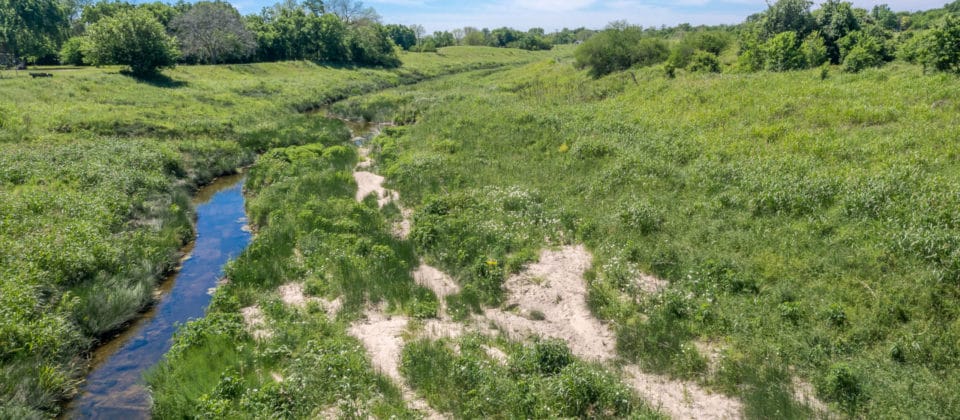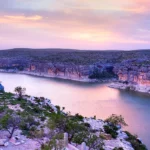The Lavaca River, often called the heart of South Texas, meanders for miles, sustaining a rich tapestry of life and culture along its banks. From its headwaters in the rolling hills to its final destination in the vast Gulf of Mexico, the Lavaca River’s journey is one of ecological diversity, historical significance, and enduring importance to the people who call this region home.
The Lavaca River in South Texas
Originating in Gonzales County, the Lavaca River embarks on a 115-mile journey southeast, gracefully winding through Lavaca and Jackson Counties before ultimately merging with the expansive Matagorda Bay. The river’s name, derived from the Spanish word for “cow” (“lavaca”), hints at its historical significance. Early ranchers relied heavily on the Lavaca River, recognizing it as a lifeline for their cattle and, thus, their livelihoods.
Despite being the smallest major river basin in Texas, the Lavaca River teems with an abundance of life. Its waters teem with a fascinating array of plants and animals, forming a complex and interconnected ecosystem. The speckled trout, a prized catch among anglers, thrives in these waters, drawing fishing enthusiasts eager to test their skills.
However, living along the Lavaca River, particularly within its floodplain, presents challenges, particularly the ever-present risk of flooding. These floods, though a natural part of the river’s cycle, can pose significant risks to communities nestled along its banks. Recognizing this, experts continuously monitor the river, employing advanced technologies to predict and prepare for potential floods, prioritizing the safety of those who live and work near the water.
Why the Lavaca River Matters:
- A Wildlife Sanctuary: The river provides a vital habitat for a diverse range of aquatic creatures, including fish, turtles, and numerous insect species. This rich biodiversity is a testament to the river’s health and ecological significance.
- An Angler’s Paradise: The Lavaca River’s reputation as a prime fishing destination, especially for speckled trout, attracts anglers from far and wide, eager to experience the thrill of reeling in these prized fish.
- Nature’s Playground: The Lavaca River offers a serene escape, inviting visitors to reconnect with nature. Kayaking along its tranquil stretches, casting a line from its banks, or simply soaking in the surrounding beauty provides respite from the demands of daily life.
Keeping an Eye on the River:
- Flood Forecasting: Scientists and engineers dedicate themselves to understanding the river’s behavior, particularly during periods of intense rainfall. This knowledge enables them to issue accurate flood warnings, providing residents with crucial time to prepare and minimize potential damage.
- Safeguarding a Precious Resource: Protecting the Lavaca River’s floodplain extends beyond safeguarding homes and businesses; it represents a commitment to preserving the unique natural environment that thrives along its banks.
The Lavaca River embodies more than just a source of water; it represents a vital thread woven into the fabric of South Texas, sustaining life, fostering memories, and shaping the region’s identity. As our understanding of this precious resource deepens, so too does our responsibility to ensure its continued health and vitality for generations to come.
Where Does the Lavaca River Start and End?
The Lavaca River begins its journey in Gonzales County, Texas, embarking on a scenic 115-mile course southeast, ultimately emptying into Lavaca Bay, an arm of the Gulf of Mexico. French explorer René-Robert Cavelier, Sieur de La Salle, bestowed upon the river its early moniker, “Rivière des Vaches,” meaning “Cow River.” This naming likely stemmed from the explorer’s observations of the region’s abundant cattle grazing near the water’s edge.
Today, the Lavaca River serves as a vibrant ecosystem, teeming with life. Speckled trout navigate its depths, turtles bask on sun-drenched rocks, insects hum along its banks, and a plethora of other aquatic creatures contribute to the river’s biodiversity. Birdwatchers, too, find solace along the Lavaca, drawn by the diverse avian species that frequent its shores.
The Lavaca River’s allure has captivated people for centuries. Its historical significance as a vital resource for ranchers, providing water for their cattle and sustenance for their livelihoods, cemented its place in the region’s history. Today, communities continue to rely on the river, utilizing its waters for fishing, recreation, and even as a source of drinking water. Established in 1941, the Lavaca-Navidad River Authority plays a crucial role in ensuring equitable access to this precious resource for all who depend on it.
Despite its resilience, the Lavaca River faces challenges. Its upper reaches, characterized by a smaller watershed and limited runoff, often experience periods of low water flow, particularly during dry spells. Additionally, the looming effects of climate change further threaten the river’s delicate balance. Fluctuations in water levels, driven by changing precipitation patterns, could impact navigability and disrupt the delicate ecosystems that rely on its steady flow.
However, despite these challenges, the Lavaca River perseveres, standing as a testament to the remarkable resilience of nature. Deeply intertwined with the history and culture of South Texas, the Lavaca River will undoubtedly continue to shape the lives of those fortunate enough to live along its banks for generations to come.
What is the History of the Lavaca River Basin?
The Lavaca River Basin boasts a rich and storied history, intricately linked to the people who have called it home for millennia. Long before European explorers set foot in the region, Native American tribes thrived along the river’s banks, relying on its life-giving waters for sustenance and weaving its presence into their cultural traditions.
The 19th century witnessed a surge in settlers drawn to the Lavaca River Basin, enticed by the promise of fertile land and abundant water resources. These pioneers established farms and communities, forever shaping the landscape and relying on the river’s bounty to fuel their growth and prosperity.
Today, the Lavaca River Basin remains a cornerstone of South Texas. Its waters irrigate crops, power homes, and quench the thirst of communities throughout the region. The river also serves as a vital source of recreation, offering opportunities for fishing, boating, and simply immersing oneself in the beauty of the natural world.
Key Facts about the Lavaca River Basin:
| Feature | Description |
|---|---|
| Size | Encompassing approximately 1,910 square miles, the Lavaca River Basin stands as the smallest major river basin in Texas. |
| Journey | From its headwaters in Gonzales County, the Lavaca River meanders southeast for 115 miles before reaching Lavaca Bay, a part of the larger Matagorda Bay. |
| Lake Texana | An integral feature within the basin, Lake Texana, formed by the Lavaca-Navidad River Dam, serves as a vital reservoir, providing drinking water, supporting industry, and offering recreational opportunities. |
While our understanding of the Lavaca River Basin has grown significantly over time, ongoing research continues to unravel new insights into its intricate history, complex ecology, and the impact of human activities. Scientists actively study the basin’s water resources, seeking to understand how they are changing and identify strategies to protect this invaluable ecosystem for future generations.
What Kind of Fish Live in the Lavaca River?
The Lavaca River, with its unique connection to the Gulf of Mexico, serves as a haven for a diverse array of fish species, attracting both seasoned anglers and those seeking a relaxing day on the water. This mixing of freshwater and saltwater creates a unique habitat that supports a wide variety of fish.
During the cooler months, speckled trout seek refuge in the Lavaca River’s deeper channels, finding respite from the colder temperatures of the Gulf. Meanwhile, largemouth bass patrol the shallower areas and hidden coves, ambushing unsuspecting crawfish and other prey. In the depths, blue catfish, known for their impressive size, lurk, waiting for the opportune moment to strike a tempting bait.
While these three species may be among the most sought-after, the Lavaca River boasts a rich diversity of fish, each contributing to the delicate balance of this unique ecosystem. Some of the common species anglers might encounter include:
| Common Name | Scientific Name | Notes |
|---|---|---|
| Red Drum | Sciaenops ocellatus | Renowned for their spirited fights and prized for their delicious fillets. |
| Black Drum | Pogonias cromis | Often found scouring the river bottom for crustaceans and mollusks. |
| Largemouth Bass | Micropterus salmoides | A favorite among anglers seeking an exhilarating challenge. |
| Speckled Trout | Cynoscion nebulosus | Highly sought after for their delicate flavor and often found near grassy areas. |
| Blue Catfish | Ictalurus furcatus | The heavyweights of the river, these fish can grow to astonishing sizes. |
| And many more! |
This list represents just a glimpse into the hidden world beneath the Lavaca River’s surface. Ongoing research continues to illuminate the intricate lives of these fish and the factors that influence their populations. For instance, some experts suggest that alterations in water flow caused by damming and changing weather patterns may be influencing fish distribution and abundance. The Lavaca River’s ecosystem, much like the fish that inhabit it, is dynamic, ever-evolving, and full of surprises.
Whether you’re a seasoned angler or just starting out, the Lavaca River promises a thrilling fishing experience and the potential for memorable catches. Always remember to consult local fishing regulations and obtain any necessary permits before casting your line. Tight lines and happy fishing!
Plan your next adventure exploring the rivers in Texas, where you can experience the thrill of tubing on the Frio River. If you’re seeking crystal-clear waters, discover the clearest water in Texas. For a unique tubing experience, explore the various rivers in Texas for tubing.
- Unlocking Francis Alexander Shields’ Finance Empire: A Comprehensive Biography - July 12, 2025
- Unveiling Francis Alexander Shields: A Business Legacy - July 12, 2025
- Francis Alexander Shields’ Business Career: A Comprehensive Overview - July 12, 2025















